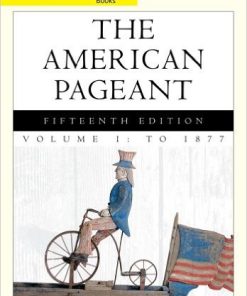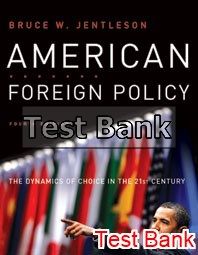Cengage Advantage American Foreign Policy and Process 6th Edition McCormick Test Bank
$26.50$50.00 (-47%)
Cengage Advantage American Foreign Policy and Process 6th Edition McCormick Test Bank.
You may also like
Cengage Advantage American Foreign Policy and Process 6th Edition McCormick Test Bank

Product details:
- ISBN-10 : 1435462726
- ISBN-13 : 978-1435462724
- Author: James M. McCormick
Offering detailed, up-to-the-minute coverage, AMERICAN FOREIGN POLICY AND PROCESS, ADVANTAGE SERIES, 6e examines the differing approaches to U.S. foreign policy for presidential administrations during America’s rise to globalism during the Cold War years, through Vietnam, and in today’s post 9/11 world. It also explores how values and beliefs about foreign policy have changed over the course of U.S. history, illustrating how domestic factors affect the foreign policy decision-making process. Through the author’s analysis of original data and depiction of current events in the political arena, the book provides the most current coverage available to help readers fully understand the American foreign policy process.
Table contents:
- Part I: Values and Policies in American Foreign Affairs
- Ch 1: America’s Traditions in Foreign Policy
- Values, Beliefs, and Foreign Policy
- The United States: A New Democratic State
- The Role of Isolationism in American Foreign Policy
- The Role of Moral Principle in American Foreign Policy
- Concluding Comments
- Notes
- Ch 2: America’s Global Involvement and the Emergence of the Cold War
- The Postwar World and American Involvement
- America’s Globalism: The Truman Doctrine and Beyond
- Elements of Containment: Regional Security Pacts
- Elements of Containment: Economic and Military Assistance
- Elements of Containment: The Domestic Cold War
- Korea: The First Major Test of Containment
- The Cold War Consensus
- The Public and the Cold War Consensus
- Challenges to the Cold War Consensus
- Concluding Comments
- Notes
- Ch 3: After the Missile Crisis and the Vietnam War: Realism and Idealism in Foreign Policy
- Challenges to the Cold War Consensus at Home
- Vietnam
- Realism and Idealism as Foreign Policy Concepts
- Realism and the Nixon Administration
- The Nixon-Kissinger Worldview in Operation
- Idealism and the Carter Administration
- The Carter Worldview in Operation
- Realism in the Last Year: A Response to Critics
- Concluding Comments
- Notes
- Ch 4: The Return and End of the Cold War: The Reagan and Bush Administrations
- Realism and the Reagan Administration
- The Reagan Worldview in Operation
- Challenges to the Reagan Foreign Policy Approach
- Policy Change: Accommodation with the Soviet Union
- Policy Continuity: The Reagan Doctrine and the Third World
- Policy Changes toward the Third World: The Philippines, the PLO, and South Africa
- Realism, Pragmatism, and the George H. W. Bush Administration
- Bush’s Foreign Policy Approach
- Political Change and Eastern Europe
- After the Cold War: Bush’s Policy toward Central Europe
- After the Cold War: Bush’s Policy toward the Soviet Union
- The Search for a New World Order?
- Challenges and Responses to the New World Order
- Concluding Comments
- Notes
- Ch 5: Foreign Policy after the Cold War and 9/11: The Clinton and Bush Administrations
- Post-Cold War Foreign Policy: The Clinton Administration
- The Clinton Administration’s Evolving Approaches to Foreign Policy
- The Legacies of the Clinton Administration’s Foreign Policy
- The International System at the Dawn of a New Century
- Before and after 9/11: The Foreign Policy of the George W. Bush Administration
- The Values and Beliefs of the Bush Administration: Prior to September 11
- Classical Realism and the Bush Approach
- The Impact of September 11
- The Values and Beliefs of the Bush Administration: After September 11
- Formalizing the Bush Doctrine: The National Security Strategy Statement
- Policy Implications of the Bush Doctrine toward the World
- After Reelection: A New Foreign Policy Approach?
- The Iraq War and Opposition to the Bush Foreign Policy
- Concluding Comments
- Notes
- Ch 6: Change and Continuity in Foreign Policy: The Barack Obama Administration
- Values and Beliefs of the Obama Administration
- The Obama Worldview in Operation
- Criticisms of the Obama Approach and Its Application
- Concluding Comments
- Notes
- Part II: The Process of Policy Making
- Ch 7: The President and the Making of Foreign Policy
- Constitutional Powers in Foreign Policy
- A Cyclical Interpretation of Foreign Policy Dominance
- Executive Dominance after World War II: The Imperial Presidency
- Concluding Comments
- Notes
- Ch 8: Congressional Prerogatives and the Making of Foreign Policy
- Commitment Making
- War Powers
- Controlling the Purse Strings
- Congressional Oversight
- Mechanisms of Congressional Influence
- Congressional Change and Future Foreign Policy Making
- Concluding Comments
- Notes
- Ch 9: The Diplomatic and Economic Bureaucracies: Duplication or Specialization?
- Bureaucratic Politics and Foreign Policy Making
- The Department of State
- The National Security Council
- Bureaucracies and Foreign Economic Policy Making
- Concluding Comments
- Notes
- Ch 10: The Military and Intelligence Bureaucracies: Pervasive or Accountable?
- The Department of Defense
- The Intelligence Community
- CIA “Special Activities” and Policy Influence
- Accountability and Covert Actions
- Changes in Accountability from Iran-Contra to Today
- The Department of Homeland Security
- Policy Coordination among Competing Bureaucracies
- Concluding Comments
- Notes
- Ch 11: Political Parties, Bipartisanship, and Interest Groups
- Political Parties and the Bipartisan Tradition
- The Limits of Bipartisanship through the Vietnam Era
- Bipartisanship and Congressional Foreign Policy Voting
- Partisan Divisions: From the Cold War to Today
- Partisan Politics and the Future
- Interest Groups and the Foreign Policy Process
- The Impact of Interest Groups
- Concluding Comments
- Notes
- Ch 12: The Media, Public Opinion, and the Foreign Policy Process
- The Pervasiveness of the Media
- The Role of the Media in the Foreign Policy Process
- The Media’s Impact on the Public
- Public Opinion and Foreign Policy: Alternate Views
- Foreign Policy Opinion: Uninformed and Moodish
- Foreign Policy Opinion: Structured and Stable
- An Alternative View of the Public Mood
- The Impact of Public Opinion on Foreign Policy
- Concluding Comments
- Notes
- Part III: Conclusion
- Ch 13: American Foreign Policy Values and the Future
- A Nation Divided
- Value Differences within Elites
- Value Differences between Elites and Masses
- Partisan Divisions on Foreign Policy
- A New Foreign Policy Consensus?
- Concluding Comments
- Notes
- A Selected Bibliography
- Name Index
- Subject Index
People also search:
Cengage Advantage American Foreign Policy and Process 6th
Cengage Advantage American Foreign Policy and Process 6th download scribd
Cengage Advantage American Foreign Policy and Process 6th pdf
Cengage Advantage American Foreign Policy and Process 6th free pdf
Cengage Advantage American Foreign Policy and Process 6th ebook












